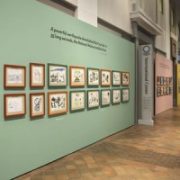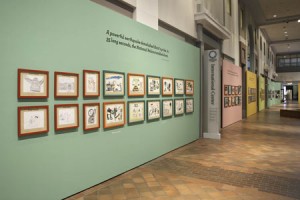Special thanks to Ellen Rosenthal, President and CEO at Conner Prairie Interactive History Park, a Smithsonian Affiliate in Fishers, Indiana, for this guest post.
Around 500 BCE the legendary Greek philosopher Heraclitus declared that the only constant is change. Imagine what he would say today.
For more than a quarter century museums have been a central part of my life (Conner Prairie Interactive History Park since 1999). It’s safe to say that I expected the world to change during my career, but at this rate? In retrospect, I was clueless.

Entering Dupont, part of the 1863 Civil War Journey at Conner Prairie. Photo courtesy Conner Prairie.
We museum leaders find ourselves in the midst of a digital revolution, globalization, new discoveries in the way people learn and retain information, the manner(s) in which information is conveyed, economic challenges (for us and for our guests), and attention spans that seem to shrink with the launch of every new Smartphone app.
So what are we to do with this tsunami of challenges facing our industry if we are to avoid being relegated to another heap within history?
Museums must not only find ways to engage today’s sophisticated and restless consumers, but we must recognize a shared need to remain relevant – to keepup with change. My 20-year-old son once challenged me, “Why do I need to go to Conner Prairie when I can experience time-travel on my laptop?” Conner Prairie has an answer.

The Depot in the 1863 Civil War Journey at Conner Prairie. Photo courtesy Conner Prairie.
The shared purpose that we embrace at Conner Prairie is to create intergenerational learning “exhibits” that pique curiosity, generate positive attitudes toward learning and encourage grandparents, parents, teachers and children to share experiences that spark conversation.
Although there are no long-term studies to prove the importance of museums to educational attainment, research on the summer learning gap shows that underprivileged students fall behind their middle-class classmates, because they do not visit museums or have other out-of-school learning experiences over the summer. There is an important role for museums to play in sustaining America’s educational competitiveness.
Conner Prairie seeks to make it easier for entire families of all income levels to share learning experiences by first, making those experiences exciting enough to leave home for, and by second, offering reduced admission based on need through the Access Program, which offers $1 admission to any Hoosier family on public assistance.

A Raided Warehouse in the 1863 Civil War Journey at Conner Prairie. Photo courtesy Conner Prairie.
We understand that if we, as a contemporary museum, are to remain relevant and at least within a thoroughbred’s length of change we must do the following:
- Look outside the museum field for models.
Consider who or what engages all family members regardless of age. Movie maker Pixar is an example, not in terms of costs, but in the way it ingeniously creates simultaneous plot lines – one that moves and amuses adults, another that speaks to kids.
- Create experience. In our recent Civil War Journey experience we used technology but not for technology’s sake. As our consultants put it: “It isn’t the whiz-bang that matters, it’s the story the whiz-bang is trying to bring to life.”
- Program for diverse audiences. If you want to engage diverse multi-generational audiences, make sure that everyone sees someone with whom they can identify. The stars of our Civil War exhibit are a 16-year-old girl; an 18-year-old escaped slave and a 12-year-old message boy.
Seventy-seven years after our founding we continue to discover that our founder Eli Lilly had at least part of the answer to our museum-industry dilemma: “nothing is done that cannot be done better.” Keep an eye on the way lives are changing and a loose grip on tradition and relevance will take care of itself.
Ellen M. Rosenthal – President and CEO
Conner Prairie Interactive History Park
Fishers, Indiana
(317) 776.6000

Civil War reenactors from throughout the Midwest portrayed Morgan’s Raiders during the creation of Conner Prairie’s new 1863 Civil War Journey: Raid on Indiana. © Conner Prairie



















